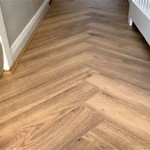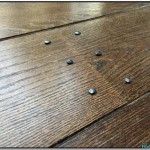Laminate Flooring: Achieving a Natural Wood Look
Laminate flooring has emerged as a popular alternative to solid hardwood, offering a cost-effective and durable solution for homeowners seeking the aesthetic of natural wood. Advanced manufacturing techniques have enabled laminate flooring to convincingly replicate the appearance of various wood species, textures, and grain patterns. This article explores the key aspects of laminate flooring that contribute to its natural wood look, examining the construction, design elements, and considerations for selecting the right product.
The allure of natural wood in interior design stems from its inherent warmth, character, and timeless appeal. Solid hardwood floors, prized for their beauty and longevity, often come with a significant price tag and require specialized installation and maintenance. Laminate flooring provides a more accessible option for achieving a similar visual effect without the associated cost and complexities.
Modern laminate flooring comprises several layers bonded together to form a durable and stable plank. Understanding the composition of laminate flooring is crucial to appreciating how it effectively mimics natural wood. These layers typically include:
- Wear Layer: The topmost layer, designed to protect the underlying decorative layer from scratches, stains, and fading. It is typically made of a clear, durable resin.
- Decorative Layer: This layer features a high-resolution photographic image of wood grain. The quality of this image is paramount in achieving a realistic wood look.
- Core Layer: The core layer provides the structural stability and impact resistance of the plank. It is typically made of high-density fiberboard (HDF) or medium-density fiberboard (MDF).
- Backing Layer: The bottom layer, which provides moisture resistance and balances the plank to prevent warping.
The interplay of these layers, particularly the decorative layer, contributes significantly to the natural wood look of laminate flooring.
Key Factors Contributing to a Natural Wood Look in Laminate Flooring
Several key factors contribute to the success of laminate flooring in replicating the appearance of natural wood. These factors encompass design elements, manufacturing processes, and technological advancements.
High-Resolution Imaging: The decorative layer is the primary determinant of the flooring's resemblance to natural wood. High-resolution photography and printing technology are used to capture intricate details of various wood species, including grain patterns, knots, and color variations. The more realistic and detailed the image, the more convincing the wood look will be.
Manufacturers often use sophisticated scanning techniques to capture the nuances of real wood planks. This allows them to create highly accurate and detailed images that are then printed onto the decorative layer. The use of advanced printing processes ensures that the colors are vibrant and true to life, further enhancing the realism of the flooring.
Embossing Techniques: Embossing, or texturing, plays a crucial role in replicating the tactile feel of natural wood. Embossed-in-register (EIR) technology aligns the embossing pattern with the printed wood grain, creating a synchronized texture that mimics the feel of real wood. This means that the texture follows the grain of the wood in the decorative image, adding depth and realism to the flooring.
Other embossing techniques, such as hand-scraped or wire-brushed textures, can also be applied to the surface of the laminate flooring to further enhance its authenticity. These textures mimic the natural wear and tear that occurs over time in solid hardwood floors, adding character and visual interest.
Plank Dimensions and Layout: The size and shape of the laminate planks, as well as the way they are laid out, can significantly impact the overall appearance of the flooring. Wider planks, for example, tend to mimic the look of more expensive hardwood floors. Varying the length of the planks can also create a more random and natural look.
The way the planks are laid out can also affect the visual impact of the flooring. Staggered layouts, where the end joints of adjacent planks are offset, create a more organic and less uniform appearance, similar to that of real wood floors. Paying attention to these details can significantly enhance the natural wood look of laminate flooring.
Selecting Laminate Flooring for a Realistic Wood Appearance
Choosing the right laminate flooring to achieve a realistic wood look requires careful consideration of several factors. These include the desired wood species, color variations, texture, and overall quality of the product.
Wood Species and Color: Laminate flooring is available in a wide range of wood species and color variations, from light and airy maple to rich and dark walnut. Consider the overall aesthetic of the room and choose a wood species and color that complements the existing décor. It is important to view samples of the flooring in different lighting conditions to ensure that the color is consistent with your expectations.
Texture and Embossing: Pay close attention to the texture and embossing of the laminate flooring. Opt for products with embossed-in-register (EIR) technology to achieve a more realistic feel. Consider the desired level of texture, from smooth and subtle to heavily textured, depending on the desired look.
Plank Size and Shape: Choose plank sizes and shapes that are appropriate for the size of the room. Wider planks can make a small room feel more spacious, while narrower planks may be more suitable for larger rooms. Consider the overall layout of the room and choose plank dimensions that will create a visually appealing and balanced look.
Quality and Durability: While aesthetics are important, it is also crucial to consider the quality and durability of the laminate flooring. Look for products with a high AC rating (Abrasion Class), which indicates the flooring's resistance to wear and tear. Choose a product that is appropriate for the level of traffic in the room where it will be installed.
Underlayment: The underlayment provides a cushion between the subfloor and the laminate flooring, reducing noise and increasing comfort underfoot. Proper underlayment can also improve the overall performance of the flooring and extend its lifespan. Select an underlayment that is specifically designed for laminate flooring and meets the manufacturer's recommendations.
Maintaining Laminate Flooring's Natural Wood Look
Proper maintenance is essential for preserving the natural wood look of laminate flooring and extending its lifespan. Regular cleaning and preventative measures can help to protect the flooring from scratches, stains, and other damage.
Regular Cleaning: Sweep or vacuum the flooring regularly to remove dirt, dust, and debris. Use a soft-bristled broom or a vacuum cleaner with a floor brush attachment to avoid scratching the surface. Avoid using harsh chemicals or abrasive cleaners, which can damage the wear layer and dull the finish.
Damp Mopping: Damp mop the flooring with a mild detergent and water as needed. Be sure to wring out the mop thoroughly to prevent excess water from seeping into the seams. Avoid using steam mops, as the high heat and moisture can damage the laminate flooring.
Preventative Measures: Place mats or rugs at entrances to trap dirt and moisture. Use felt pads under furniture legs to prevent scratches and dents. Avoid wearing shoes with high heels or cleats on the flooring. Clean up spills immediately to prevent staining.
Repairing Scratches and Dents: Minor scratches and dents can often be repaired with touch-up kits specifically designed for laminate flooring. These kits typically include a filler compound and a variety of color-matching markers to conceal the damage. For more severe damage, it may be necessary to replace the affected plank.
By following these maintenance tips, homeowners can ensure that their laminate flooring retains its natural wood look for years to come. Regular cleaning and preventative measures will help to protect the flooring from everyday wear and tear, preserving its beauty and extending its lifespan.
The advancements in laminate flooring technology continue to blur the lines between synthetic and natural materials. The commitment to high-resolution imaging, realistic embossing, and durable construction allows homeowners to enjoy the aesthetic benefits of natural wood with the added advantages of affordability and ease of maintenance that laminate flooring provides. Choosing the right product and implementing proper care techniques ensures a long-lasting and visually appealing floor that complements any interior design.

Goodhome Dawnham Natural Wood Effect Laminate Flooring 2 543m² Diy At B Q

Goodhome Leyton Natural Wood Effect Laminate Flooring 1 72m² Diy At B Q

Goodhome Lulea Pure Natural Wood Effect Laminate Flooring 1 995m² Diy At B Q

Bravo Wood Effect Flooring 1 76m² Diy At B Q

Wood Look Laminate Flooring Ll

Natural Wood Look 12mm Pvc Frame Laminate Flooring China Made In Com

Colours Dolce Walnut Effect Laminate Flooring 1 19m² Diy At B Q

8 Fake Wood Flooring Options 2024 A Full Guide And Reviews

Timber Wood Natural Ceramic Floor 250x500mm Tile

Vinyl Flooring That Looks Like Wood Lx Hausys
Related Posts








